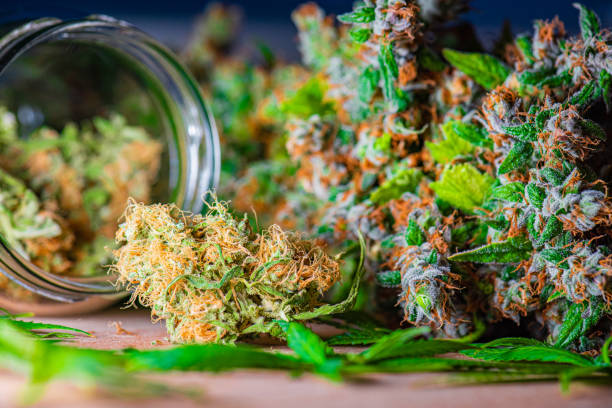Perimenopause is a natural phase that marks the transition to menopause, typically starting in a woman’s 40s but sometimes as early as the mid-30s. This period can bring about a variety of symptoms that impact daily life. In recent years, cannabis has emerged as a potential aid for managing these symptoms.
In this article we’ll explore:
- The common symptoms of perimenopause, including mood swings, hot flashes, and sleep disturbances.
- How cannabis can alleviate these symptoms through its interaction with the endocannabinoid system.
- The potential benefits and considerations of using cannabis as a treatment option during this phase.
What is Perimenopause?
Perimenopause is the time leading up to menopause when the ovaries gradually begin to produce less estrogen. This phase can last anywhere from a few months to several years. It officially ends once a woman has gone 12 months without a menstrual period. During this stage, many women experience a range of symptoms due to hormonal changes.
Common Symptoms of Perimenopause
Understanding the symptoms is essential for identifying effective relief methods. Some common symptoms include:
- Hot Flashes: Sudden feelings of heat that spread mainly over the face, neck, and chest.
- Night Sweats: Excessive sweating during the night, often disrupting sleep.
- Mood Swings: Emotional fluctuations that can range from irritability to depression.
- Sleep Disturbances: Difficulty falling asleep or staying asleep.
- Vaginal Dryness: Reduced moisture and elasticity in the vaginal tissues, leading to discomfort.
- Decreased Libido: A reduction in sexual desire.
- Weight Gain: An increase in weight, particularly around the abdomen.
- Fatigue: Persistent tiredness and lack of energy.
- Memory Problems: Difficulty concentrating or remembering things.
How Cannabis Can Help
It contains compounds called cannabinoids, such as THC (tetrahydrocannabinol) and CBD (cannabidiol), which interact with the body’s endocannabinoid system to regulate various functions. But what does THC and CBD do together to provide such relief? When combined, THC and CBD work synergistically, balancing each other out while enhancing their therapeutic effects.
Here’s how it can help alleviate some of the most common symptoms:
Hot Flashes and Night Sweats
Hot flashes and night sweats can be particularly disruptive. It helps regulate body temperature through its interaction with cannabinoid receptors in the brain.
- THC and CBD: Both THC and CBD have properties that help stabilize body temperature. Products like tinctures and edibles can provide a more prolonged effect.
Mood Swings and Emotional Fluctuations
Mood swings during this stage can be intense. It has been shown to have mood-stabilizing effects, thanks to its influence on serotonin and dopamine levels in the brain.
- CBD: Known for its anti-anxiety and antidepressant properties, CBD can help regulate mood and reduce anxiety. CBD oils and capsules are popular choices.
Sleep Disturbances
Sleep disturbances are another common problem. It can promote better sleep by addressing the root causes of insomnia, such as anxiety and pain.
- Indica Strains: Indica-dominant strains are often recommended for their relaxing and sedative effects. They can help you fall asleep faster and stay asleep longer.
- Edibles: Edibles can provide a longer-lasting effect, making them a good option for those who struggle to stay asleep.
Vaginal Dryness and Discomfort
It can also aid in managing vaginal dryness.
- CBD Lubricants: These products can enhance moisture and reduce discomfort during intercourse. They also have anti-inflammatory properties that can help soothe irritated tissues.
Decreased Libido
A decrease in libido is a common complaint during this period. It can enhance sexual desire and pleasure by increasing blood flow and reducing anxiety.
- THC: THC can heighten sensory perception, enhancing sexual pleasure. Microdosing can be an effective way to use THC for this purpose without feeling overly intoxicated.
Weight Gain and Metabolism
Weight gain during this time is often linked to hormonal changes and a slower metabolism. It can influence metabolism through its interaction with the endocannabinoid system.
- THCV: Tetrahydrocannabivarin (THCV) is a cannabinoid known for its appetite-suppressing properties. Strains high in THCV can help manage weight gain.
Fatigue
Fatigue can be overwhelming during this phase. It can help boost energy levels when used appropriately.
- Sativa Strains: Sativa-dominant strains are known for their uplifting and energizing effects. They can help combat fatigue and improve focus.
Memory Problems
Memory problems can be frustrating. It may help improve cognitive function by reducing stress and anxiety, which are often underlying issues.
- Microdosing: Small doses can help improve concentration and memory without causing significant impairment.
How to Use Cannabis Safely
It’s important to use it responsibly, especially if you are new to it. Here are some tips:
- Start Low, Go Slow: Begin with a low dose and gradually increase it until you find the amount that works best for you.
- Consult a Healthcare Provider: Always talk to your doctor before starting any new treatment, especially if you are taking other medications.
- Choose the Right Product: There are many forms, including oils, edibles, tinctures, and topicals. Choose the one that best suits your needs.
- Understand the Law: Make sure you are aware of the legal status in your area.
Potential Side Effects
While it can provide relief for many symptoms, it is essential to be aware of potential side effects. Some individuals might experience:
- Dry Mouth: Also known as cottonmouth, this can be alleviated by staying hydrated.
- Dizziness: Especially at higher doses, it can cause light-headedness or dizziness.
- Increased Anxiety: In some cases, THC can heighten anxiety or paranoia; starting with low doses can help mitigate this risk.
- Impaired Coordination: It can affect motor skills and reaction times, so avoid activities like driving after use.
- Tolerance and Dependence: Frequent use can lead to increased tolerance, meaning you might require more over time to achieve the same effects. Responsible use is key to preventing dependence.
Knowing these potential side effects can help you make informed choices and use them more safely to manage symptoms.
Conclusion
Perimenopause can be a challenging time, but cannabis offers a natural and effective way to manage many of its symptoms. From hot flashes to mood swings, sleep disturbances to vaginal dryness, it has shown promise in providing relief. Remember to consult with a healthcare provider to ensure it’s the right choice for you and to use it responsibly.

